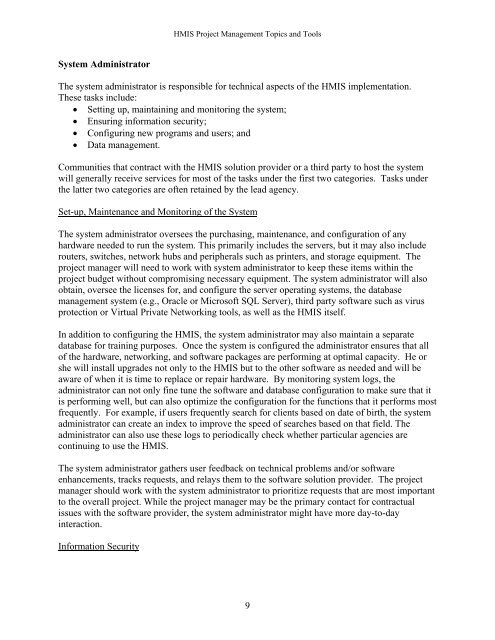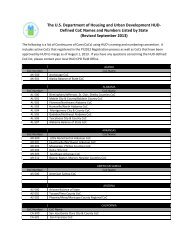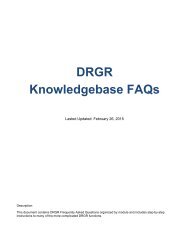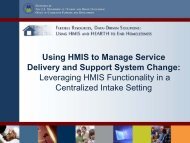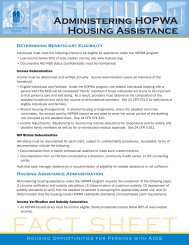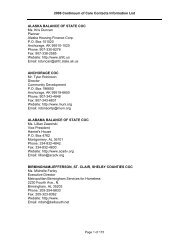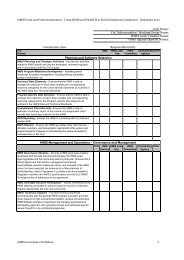HMIS Project Management Topics and Tools - OneCPD
HMIS Project Management Topics and Tools - OneCPD
HMIS Project Management Topics and Tools - OneCPD
- No tags were found...
You also want an ePaper? Increase the reach of your titles
YUMPU automatically turns print PDFs into web optimized ePapers that Google loves.
<strong>HMIS</strong> <strong>Project</strong> <strong>Management</strong> <strong>Topics</strong> <strong>and</strong> <strong>Tools</strong>System AdministratorThe system administrator is responsible for technical aspects of the <strong>HMIS</strong> implementation.These tasks include:• Setting up, maintaining <strong>and</strong> monitoring the system;• Ensuring information security;• Configuring new programs <strong>and</strong> users; <strong>and</strong>• Data management.Communities that contract with the <strong>HMIS</strong> solution provider or a third party to host the systemwill generally receive services for most of the tasks under the first two categories. Tasks underthe latter two categories are often retained by the lead agency.Set-up, Maintenance <strong>and</strong> Monitoring of the SystemThe system administrator oversees the purchasing, maintenance, <strong>and</strong> configuration of anyhardware needed to run the system. This primarily includes the servers, but it may also includerouters, switches, network hubs <strong>and</strong> peripherals such as printers, <strong>and</strong> storage equipment. Theproject manager will need to work with system administrator to keep these items within theproject budget without compromising necessary equipment. The system administrator will alsoobtain, oversee the licenses for, <strong>and</strong> configure the server operating systems, the databasemanagement system (e.g., Oracle or Microsoft SQL Server), third party software such as virusprotection or Virtual Private Networking tools, as well as the <strong>HMIS</strong> itself.In addition to configuring the <strong>HMIS</strong>, the system administrator may also maintain a separatedatabase for training purposes. Once the system is configured the administrator ensures that allof the hardware, networking, <strong>and</strong> software packages are performing at optimal capacity. He orshe will install upgrades not only to the <strong>HMIS</strong> but to the other software as needed <strong>and</strong> will beaware of when it is time to replace or repair hardware. By monitoring system logs, theadministrator can not only fine tune the software <strong>and</strong> database configuration to make sure that itis performing well, but can also optimize the configuration for the functions that it performs mostfrequently. For example, if users frequently search for clients based on date of birth, the systemadministrator can create an index to improve the speed of searches based on that field. Theadministrator can also use these logs to periodically check whether particular agencies arecontinuing to use the <strong>HMIS</strong>.The system administrator gathers user feedback on technical problems <strong>and</strong>/or softwareenhancements, tracks requests, <strong>and</strong> relays them to the software solution provider. The projectmanager should work with the system administrator to prioritize requests that are most importantto the overall project. While the project manager may be the primary contact for contractualissues with the software provider, the system administrator might have more day-to-dayinteraction.Information Security9


